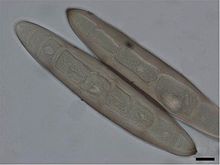Setosphaeria turcica
| Setosphaeria turcica | |
|---|---|
 |
|
| Scientific classification | |
| Kingdom: | Fungi |
| Phylum: | Ascomycota |
| Class: | Dothideomycetes |
| Subclass: | Pleosporomycetidae |
| Order: | Pleosporales |
| Family: | Pleosporaceae |
| Genus: | Setosphaeria |
| Species: | S. turcica |
| Binomial name | |
|
Setosphaeria turcica (Luttr.) K.J. Leonard & Suggs, (1974) |
|
| Synonyms | |
|
Bipolaris turcica (Pass.) Shoemaker, (1959) |
|
Bipolaris turcica (Pass.) Shoemaker, (1959)
Drechslera turcica (Pass.) Subram. & B.L. Jain, (1966)
Exserohilum turcicum (Pass.) K.J. Leonard & Suggs, (1974)
Helminthosporium inconspicuum Cooke & Ellis, (1878)
Helminthosporium turcicum Pass., (1876)
Keissleriella turcica (Luttr.) Arx, Gen. (1970)
Luttrellia turcica (Pass.) Khokhr. [as 'Lutrellia'], (1978)
Trichometasphaeria turcica Luttr., (1958)
Setosphaeria turcica (anamorph Exserohilum turcicum; formerly known as Helminthosporium turcicum) is the causal agent of northern corn leaf blight in maize. It is a serious fungal disease prevalent in cooler climates and tropical highlands wherever corn is grown. It is characterized by large cigar shaped necrotic lesions that develop on the leaves due to the polyketide metabolite monocerin.
...
Wikipedia
